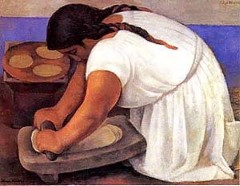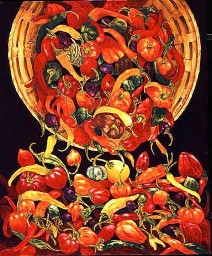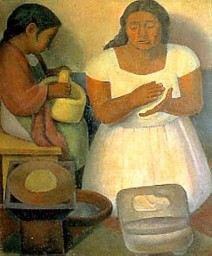Mexican Kitchen
I first met the comadre through a colleague of mine at the University of Puebla, Mexico. I was in the habit of bringing meat loaf, mashed potatoes, and other “gringo food” that the professor’s elderly American father missed, to his house in Cholula, the small town where we both lived, and where the comadre worked as his housekeeper. She would peer suspiciously at the brown gravy being ladled over his mashed potatoes, probably wondering how on earth el señor could prefer this insipid-looking sauce to one of her rich moles. Now, many years later, I wonder myself.

The comadre’s name was Lourdes, but nobody in the neighborhood, or even in town for that matter, called her by her given name. That was because nearly everyone was connected to her through the Mexican relationship called compadrazco, which is a formal tie outside the sphere of blood relatives, involving the participation of a non-family member in sponsoring a family fiesta. Food, liquor, flowers and other decorations all require the cooperation of several patrons, who are thereafter addressed as comadre or compadre instead of by their first names, at least in Mexican towns with strong traditions.
Since Lourdes had sixteen children, all of whom required decent fiestas to celebrate baptisms, first communions and weddings, not to mention quinceañeras – “sweet-fifteen” parties – for the girls, her social calendar was full and she was the quintessential comadre. It wasn’t long before my husband and I were invited to join the ranks of her hugely extended family, starting off as the providers of the sidral – a champagne-like hard cider – for a wedding toast. (The daughter whose wedding was being celebrated had been one of my students at the university, a fact that had not gone unnoticed by the town’s cleverest party planner.)

Ordering cider was one thing; the interesting part started when the comadre asked me to help out with some of the food preparation. I liked to cook and, coming from a family in the restaurant business, felt quite at home in the kitchen. What a shock then, to find out that I hadn’t the slightest idea of how to make rice, at least not according to the standards of the comadre and most decent Mexican cooks. She spent at least an hour demonstrating, and then carefully observing, as I learned to prepare arroz rojo.
Unfortunately, arroz rojo was the standard second course in almost all of the fiestas put on by the comadre, and once I mastered it to her satisfaction I made endless amounts of it before I was deemed ready to move on to other specialties.
However, move on I did, traveling frequently to other parts of Puebla and different regions of Mexico, where my husband and I enjoyed eating in marketplaces and street stalls, restaurants and private homes. I would happily accept invitations into the kitchen, whether indoors or out, while Larry hunted rabbits, picked papayas, or sampled the local pulque with someone’s husband, brother or son.

Learning to cook regional food involved a variety of settings, from humble outdoor kitchen huts in the sierra to modern restaurant facilities. The comadre’s own kitchen, a large and hectic venue, had three stoves, at least a half dozen blenders and a microwave which, though not used, was displayed proudly, covered with an embroidered doily. Several daughters-in-law would chop, slice, mince, dice and of course, grind the chiles and spices that combined to make moles, pipianes, and the stews called guisados.
I learned to prepare these and more in the years that followed my first cooking lessons from Lourdes, and found that good, regional Mexican cooking is not as complicated as many English-language Mexican cookbooks make it appear. Even a reader just starting to cook regional Mexican food should try one or two of the following favorite recipes from the comadre’s kitchen.
Recipes:
- Mexican fava bean soup: Caldo de habas vegetariano
- Stewed beef shanks with vegetables: Guisado de chambarete
- Mushrooms in vinaigrette: Hongos en escabeche
- Puebla style eggnog: Rompope

